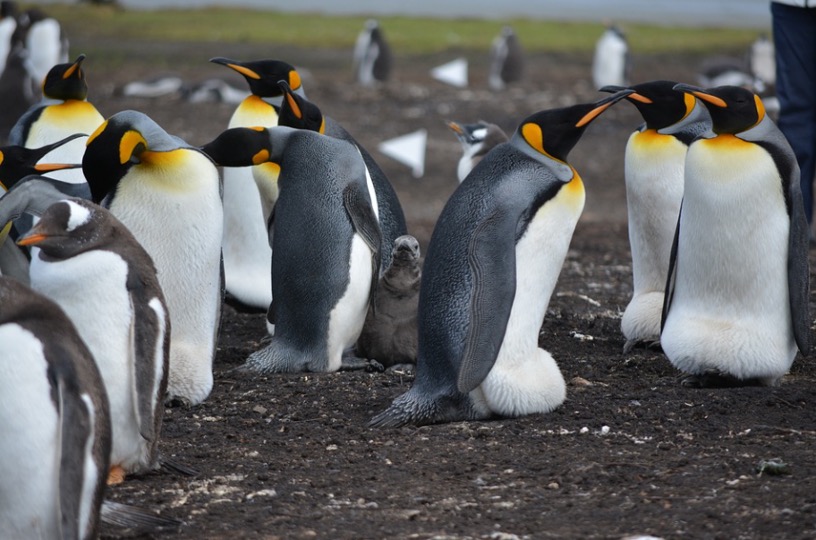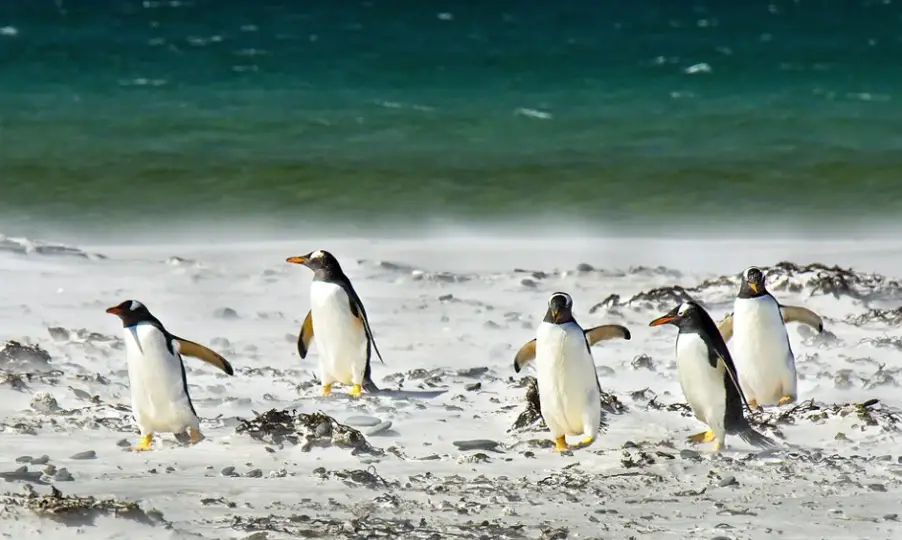Table of Contents
Penguins: All You Need To Know
Penguins are a group of flightless birds which belongs to the kingdom of Animalia, phylum Chordata, and class Aves. It has 6 genera and 18 species. Its length is 38.1 to 106.7 cm and it weighs up to 0.9 to 39 kg. It lives in the oceans and coastal areas with a lifespan up to 2 years.

What is Penguins?
Penguins are a gathering of flightless birds that are only discovered south of the equator. Just a single animal groups, the Galapagos penguin, is found in the northern half of the globe. Penguins are amphibian birds and are profoundly adjusted for life in the water, where they spend roughly a large portion of their lives.

At the point when the vast majority consider penguins, they consider chilly, cold environments yet not all types of penguins are found in the Antarctic. Some are fanned out all through the southern half of the globe, including nations like New Zealand, Australia, Chile, Peru, and surprisingly southern Africa!
The Galapagos penguin is found in warm environments close to the equator. Penguins change enormously in size and the bigger penguins are bound to be found in colder environments.

The biggest penguin is the emperor penguin which can arrive at roughly 3.6 feet (1.1 meters) in tallness and weigh somewhere in the range of 59.5 and 90 lbs (27 and 41 kilograms).
Conversely, the littlest penguin, the little blue or the fairy penguin, is 10 – 12 inches (25 – 30 cm) in stature, and its normal weight is 2.2 lbs (1 kilogram). In spite of the fact that penguins cannot fly, they are great swimmers!
Their wings behave like solid flippers, assisting them with moving rapidly through the water. Penguins swim to profundities of 20 meters looking for food, albeit a few animal varieties have been recorded as swimming as profound as 30 meters!
These birds can pause their breathing for a normal of a few minutes submerged which helps them when they are hunting. Penguins for the most part arrive at sexual development somewhere in the range of three and eight years old.
The reproducing season as a rule happens in the spring and midyear months, when the male builds up a home site and attempts to draw in a female. Most penguins are monogamous for the mating season. A few animal types, similar to the head penguins, structure states to settle while others dive tunnels or make homes in caves or under rocks.
Penguins regularly produce two eggs, aside from the ruler and lord penguins who produce just one. Both the male and female invest energy brooding the egg, while the other parent heads out to look for food.
Over portion of the world’s penguins are compromised with annihilation. Five penguin species are recorded as jeopardized by the IUCN’s Red List; the yellow-eyed penguin, the erect-crested penguin, the Northern rockhopper penguin, the African penguin, and the Galapagos penguin.
Five further species are recorded as defenseless. The greatest dangers to penguin populaces incorporate environmental change, overfishing, the obliteration of their natural surroundings, and obtrusive infections.
Types of Penguins
There are 18 types of penguins altogether. These reach from the little blue penguin found in New Zealand, to the strong ruler that lives neglected and frigid environment of the Antarctic. We should investigate some of them. Emperor Penguin (Aptenodytes forsteri) is the biggest of the penguin species, this huge bird can be over a meter in stature.
They live in provinces on the Antarctic ice, where they keep each other warm from the breeze chills which can reach – 76 degrees Fahrenheit. Emperor penguins cluster together and alternate moving to the gathering’s inside to heat up. When the penguin has heated up it will move to the external edge of the gathering to allow one more penguin to escape from the cold wind!
Macaroni Penguin (Eudyptes chrysolophus) is additionally found in the Antarctic and encompassing islands, macaroni penguins are peaked penguins and have an orange peak that streams back from the focal point of their brow.
Macaroni penguins are the most various of all penguin species and it is assessed that there are 18 million of these penguins in the wild today! African Penguin (Spheniscus demersus) are found in huge settlements along the rocky shoreline of southern Africa.
The biggest settlement is found on Dyer Island. To adapt to the more hot climate found in southern Africa, these penguins have a little pink glands over each eye. At the point when the penguins get hot, blood is shipped off this gland where it is cooled by the encompassing air. The more blazing the penguins get, the more blood is sent here and the pinker the gland becomes.
Blue Penguin (Eudyptula minor) otherwise called the little penguin, the pixie penguin, or the little blue penguin, this is the tiniest of the penguin species and gets its name from the record blue and indigo feathers that are found on top of its body.
Grown-ups average between 10 – 12 inches (25 – 30 cm) in tallness and weigh simply 2.2 – 3.3 lbs (1 – 1.5 kg). These penguins are found in the seaside spaces of Australia and New Zealand. Galapagos Penguin (Spheniscus mendiculus) is endemic to the Galapagos Islands and is the only penguin discovered north of the equator.
These penguins are recorded as imperiled and it is assessed that there are only 2000 remaining. The primary dangers to these creatures incorporate contamination, environmental change, and getting found out as bycatch in fishing nets. Humboldt Penguin (Spheniscus humboldti) is medium-sized penguin is found on islands and rough seaside spaces of Chile and Peru in the southeastern Pacific Ocean.
Exploration has shown that these penguins travel significant distances between their reproducing and taking care of grounds. Humboldt penguins are tunneling penguins and assemble their home destinations in guano (fecal) deposits.
Fun Facts About Penguins!
Penguins are flightless, aquatic birds that are generally found in the southern side of the equator. These birds are incredible swimmers and spend a ton of their lives swimming and taking care of in the sea waters. They make them astonish biological variations that assist them with carrying on with their life in the water. How about we investigate some of them!
Penguins: a Waterproofing Gland
One astounding transformation that penguins have is the oil gland, likewise called the preen gland. This organ produces waterproofing oil that the penguins can spread over their plumes.
In addition to the fact that this oils assist penguins with protecting their body from the cold water, yet it additionally assists with reduce friction, permitting them to float through the water. The logical name for this gland is the uropygial glands and it is generally evolved in birds that live on the water since it supports waterproofing the quills.
Penguins: a Yearly Moult
Unlike most birds that shed many feathers at a time, penguins undergo a full molt and lose all their feathers right away in an exceedingly method referred to as harmful molt! As penguins aren’t waterproof after they lose their feathers, they condense their shedding amount into a brief time that they need to be land, and end the method as shortly as attainable.
Molting may be a three-stage method. for many sphenisciform seabird species, this molt happens when breeding. within the 1st stage of moulting – that happens when the chicks leave – the oceanbird} goes to sea to feed for some weeks and placed on some pounds before returning to land to molt. throughout now the penguin’s body is already creating the new feathers.
Once the sphenisciform seabird returns to land, stage 2 will begin and also the bird begins to lose and replace its feathers. As a sphenisciform seabird isn’t waterproof throughout now, it stays ashore so should go hungry for many weeks! within the conclusion, the bird will come to ocean and feed to fill the load that it lost over now.
Penguins: Dense Bones
Penguins have terribly exhausting and thick bones, in contrast to different birds that have a light-weight skeleton to assist them fly. A penguin’s skeleton is heavier than different birds as a result of the bones don’t seem to be stuffed with air.
Its heavy skeleton acts sort of a different weight belt, serving to them to submerge quickly underwater after they dive. A penguin’s skeleton conjointly differs in different ways that. for instance, their wings have abundant shorter bones than the wings of different birds, and a few of those bones are amalgamate.
Their strong skeleton conjointly helps them to be powerful swimmers, providing them with stiffer fins that they use to maneuver through the water additional with efficiency.
Penguins Citations
- Blood parasites of penguins: a critical review. Parasitology . 2016 Jul;143(8):931-56.
- A Global Overview of Exposure Levels and Biological Effects of Trace Elements in Penguins. Rev Environ Contam Toxicol . 2018;245:1-64.
- Counting penguins with drones. Sci Robot . 2020 Oct 28;5(47):eabe7458.







